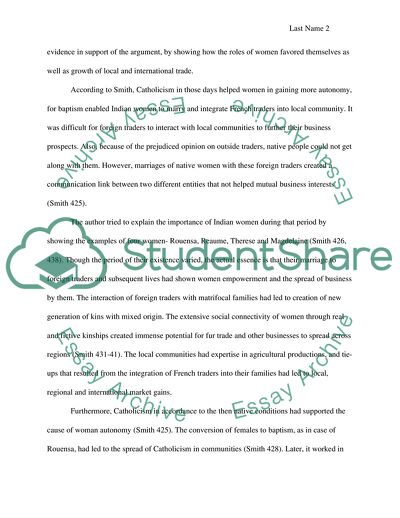
- Home
- Free Samples
- Premium Essays
- Editing Services
- Extra Tools
- Essay Writing Help
- About Us
- Studentshare
- Subjects
- Miscellaneous
- Analytical
Analytical - Essay Example

- Subject: Miscellaneous
- Type: Essay
- Level: Masters
- Pages: 4 (1000 words)
- Downloads: 0
- Author: fabernathy
Extract of sample "Analytical"
He focused on the key roles played by women in regards to kinship and Catholicism during that period and stated that Indian women acted as mediators between native communities and foreign traders in building up long term trading. In contrast to many experts who felt that Catholicism had led to decline of native culture and women’s autonomy, Smith argued that it had in reality helped women to gain social prominence (Smith 425). Lucy Eldersveld Murphy focused on Indian women across the region covered by Fox-Wisconsin and Rock river-ways in the light of French and Indian war and the Black Hawk war.
The author also tried to go against opinion that increased business in the area had forced women to settle for a subordinate role to men (Murphy 75-6). The author tried to provide substantial evidence in support of the argument, by showing how the roles of women favored themselves as well as growth of local and international trade. According to Smith, Catholicism in those days helped women in gaining more autonomy, for baptism enabled Indian women to marry and integrate French traders into local community.
It was difficult for foreign traders to interact with local communities to further their business prospects. Also, because of the prejudiced opinion on outside traders, native people could not get along with them. However, marriages of native women with these foreign traders created a communication link between two different entities that not helped mutual business interests (Smith 425). The author tried to explain the importance of Indian women during that period by showing the examples of four women- Rouensa, Reaume, Therese and Magdelaine (Smith 426, 438).
Though the period of their existence varied, the actual essence is that their marriage to foreign traders and subsequent lives had shown women empowerment and the spread of business by them. The
...Download file to see next pages Read MoreCHECK THESE SAMPLES OF Analytical
Analytical reviews
Analytical Framework
Analytical Chem
Analytical report
Analytical frameworks
Analytical Framework
Analytical Tools
Analytical Summaries

- TERMS & CONDITIONS
- PRIVACY POLICY
- COOKIES POLICY